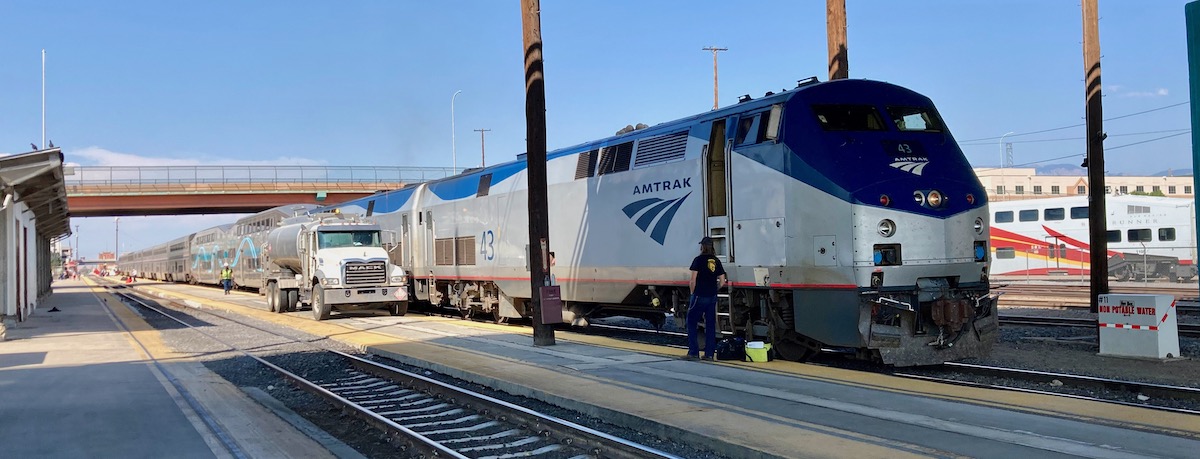
The westbound Southwest Chief is 6 minutes late out of Albuquerque, N.M., as you roll toward the junction with BNSF Railway’s Southern Transcon at Dalies. From Roomette 14 you wonder: What will happen to the Chief’s timekeeping when we hit the Gallup Subdivision that carries 80 freights per day?
The question is bigger than it may seem. Host railroad handling of Amtrak trains has become a thorny issue. Regulations that went into effect last year set new on-time performance standards and created a process to enforce them beginning July 1. And the Surface Transportation Board is bracing for a raft of Amtrak complaints about freight train interference in January, the first month when host railroads can be hauled before regulators for delaying passengers.
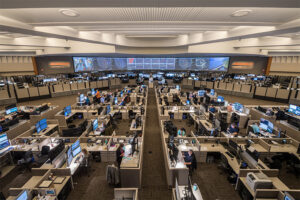
You ponder all this as the Sept. 9 version of train No. 3 leaves the quiet Glorieta Sub. The BNSF dispatcher in Fort Worth has lined your train for Track 2, and at 4:59 p.m., 11 minutes behind schedule, the Chief clunks through the interlocking at Milepost 27.3. Ahead lies 248.3 miles of the Gallup Sub, part of the former Santa Fe main line across the Southwest. It’s the busiest freight railroad in North America, and there’s no better place to judge whether freight and passenger can coexist.
Sure, the Gallup Sub is a splendid railroad built for heavy volume. Centralized traffic control, bidirectional signaling, and crossovers spaced 10 miles apart provide maximum flexibility. But the dispatching challenge is not merely volume. For this is a multispeed railroad, with the 90-mph Chief, 70-mph Z-symbol intermodal hotshots, a 55-mph limit on the heaviest trains, and grain trains that plod along at 40. Toss in grades – westbounds face a 96-mile 0.6% pull with short sections of 1% at the beginning and end of the climb – and it’s more difficult to keep freights out of the Chief’s way. And maintaining schedules by having the Chief and Z-trains overtake slower traffic chews up precious capacity in a hurry.
In the first 45 minutes out of Dalies, you see just a single freight train. A lull on the Southern Transcon means one thing: A parade is coming. Sure enough, the march begins at 5:49 at McCartys, where we swing over to Track 1 to overtake a pair of westbounds. Then at 6 p.m. it’s back into the flow of westward traffic on Track 2 at East Grants, where eastbound stacks on Track 1 had slowed to await the Chief.
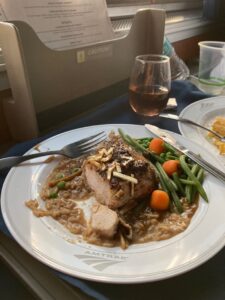
After this flurry there’s a welcome break in the action. A delicious dinner, fresh from the dining car’s galley, arrives in Roomette 14. The pan-roasted chicken breast with wild mushroom risotto, English peas, and Parisian carrots smothered in a morel mushroom sauce tastes every bit as good as it sounds. It’s a far cry from the microwaved meals Amtrak inflicted on you earlier in the pandemic.
Right after you join the Clean Plate Club – savoring the last bite of flourless chocolate torte – BNSF reminds you there’s a world of freight outside your window. Just east of Gallup, N.M., the first of two eastbounds fly by at 6:35 p.m. The Chief pulls into Gallup 8 minutes late as another eastbound roars past. A crush of coach passengers puts the Chief 15 minutes behind as we whistle west at 7:01 p.m.
Then it’s nonstop trains. Eastbound intermodal at 7:03, empty hoppers 16 minutes later, and at 7:33, the Chief swings over to Track 1 at East Houck, Ariz., where an eastbound domestic stack train holds on Track 2. The 2-mile-long train’s hind end sits just clear of the crossover at West Houck, where the Chief heads back to Track 2. Minutes later, two eastbound intermodals flash past.
Approaching Winslow, Ariz., and the Seligman Sub, the Chief is back on Track 1 to overtake a Z-train at Manila, then veers over to Track 2 at West Hibbard as more eastbounds roll by. The Chief eases into the station stop at Winslow 22 minutes late, a loss of 7 minutes from Gallup. In Roomette 14, it’s time to convert the seats into a bunk and get some shuteye after watching a masterful dispatching job that kept the Gallup Sub fluid while causing no unreasonable delays to the Chief.

In the predawn darkness, you wake for your stop at San Bernardino, Calif., where the Chief’s 9 minutes early. No. 3 reaches its ultimate destination, Los Angeles Union Station, 46 minutes to the good. Yes, Amtrak and freight can coexist – so long as there’s a commitment to priority trains and first-rate dispatching that keeps traffic rolling. BNSF shows how to get the job done.
You can reach Bill Stephens at bybillstephens@gmail.com and follow him on LinkedIn and Twitter @bybillstephens






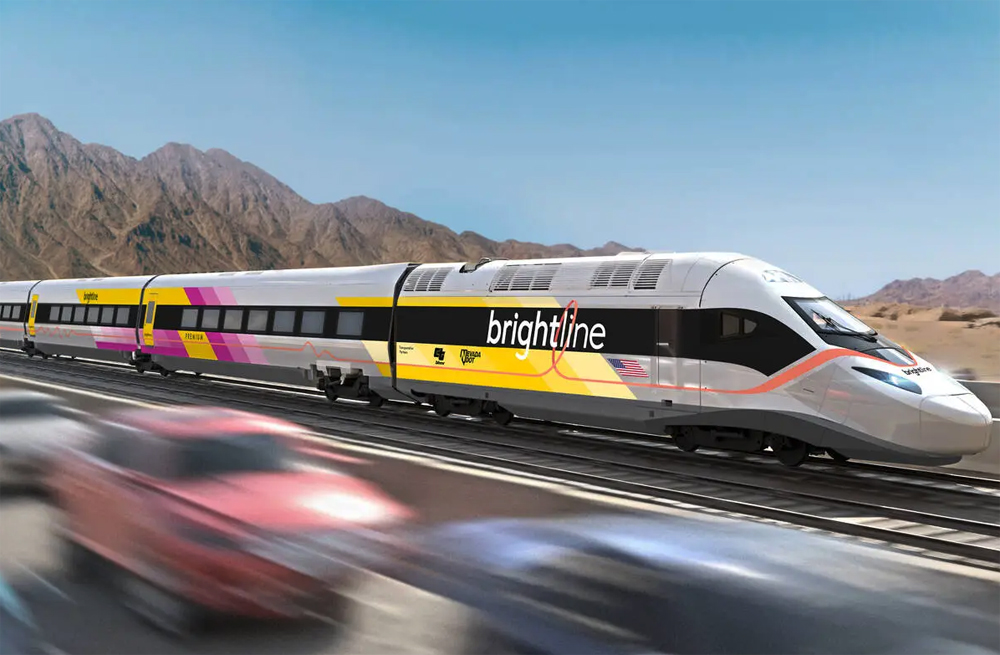
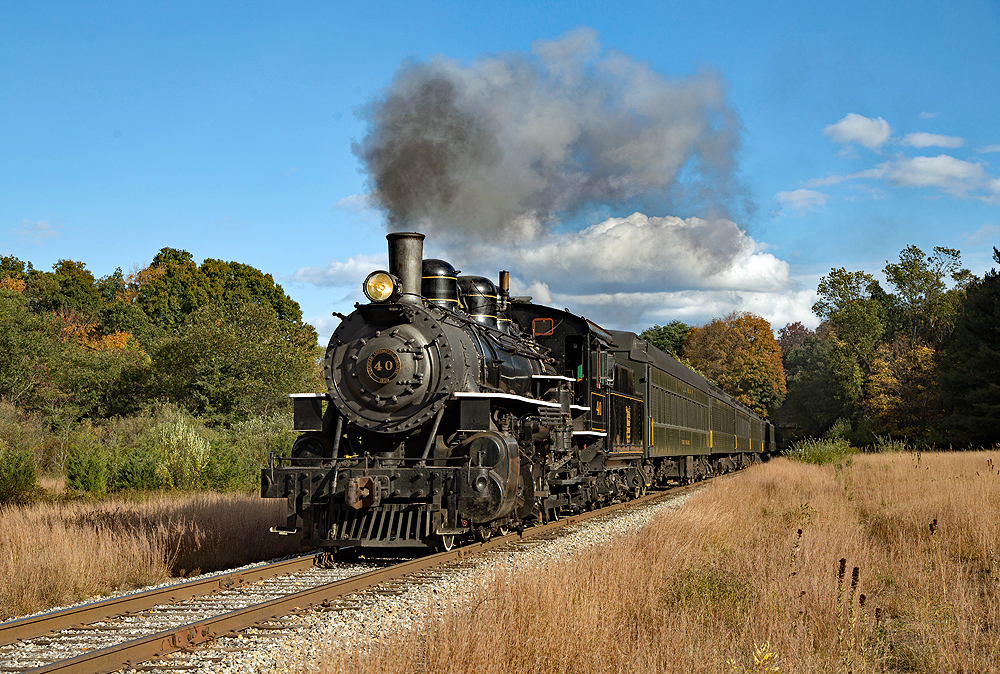
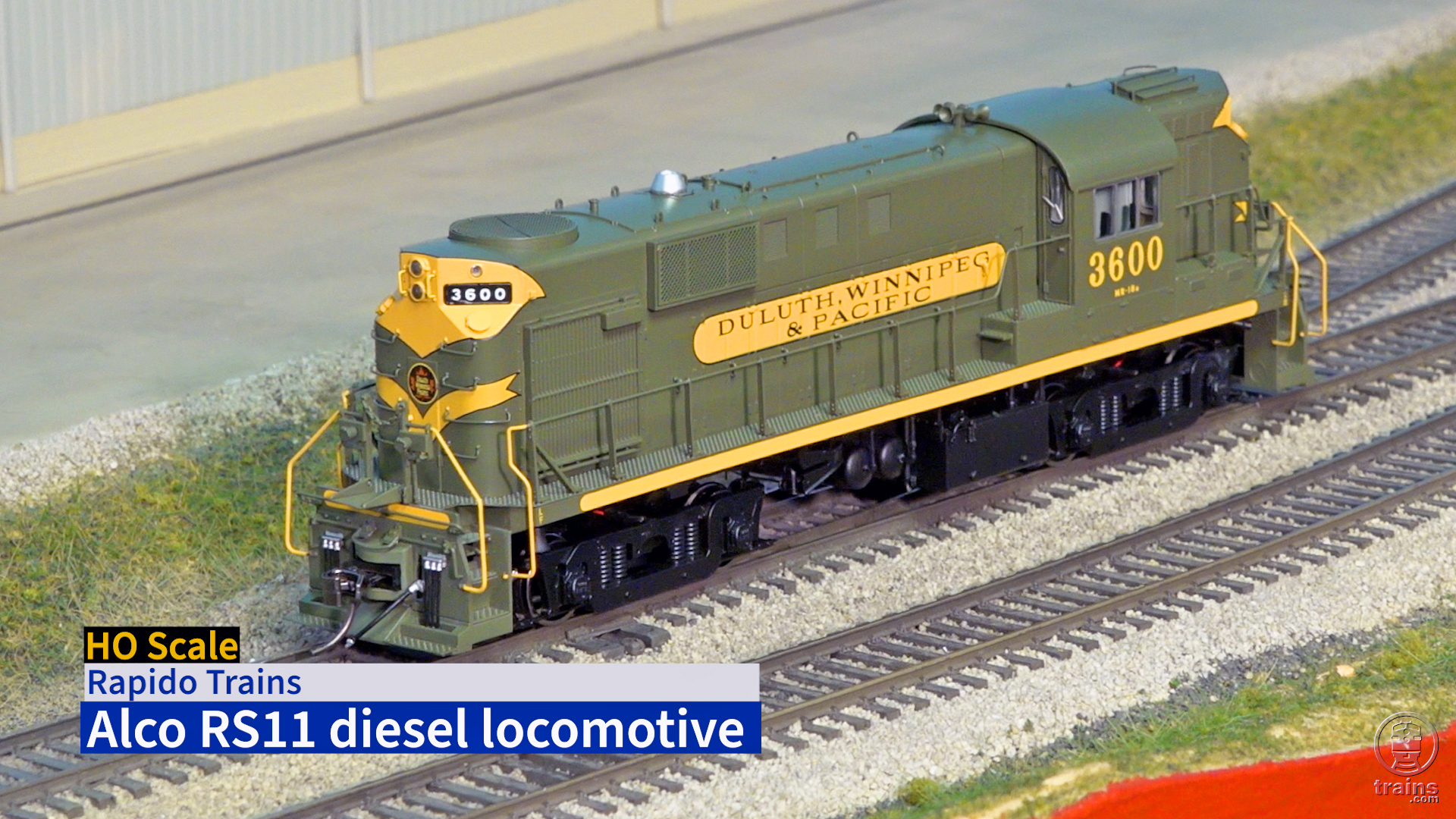
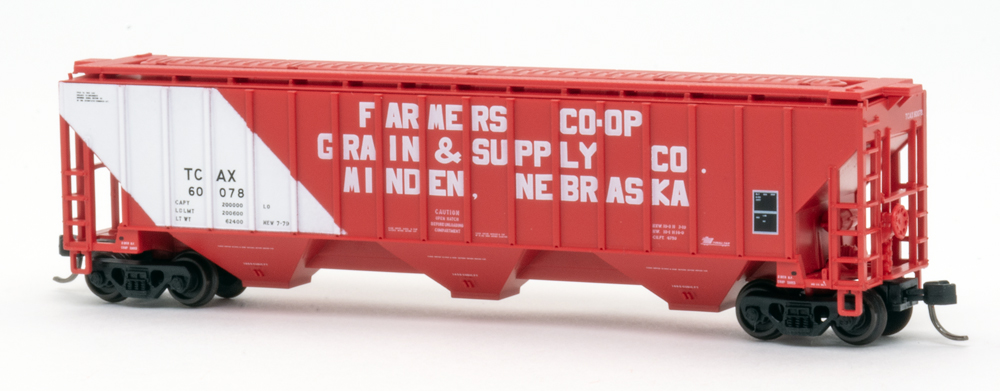




”
It’s the busiest freight railroad in North America, and there’s no better place to judge whether freight and passenger can coexist.
”
Not really. Yes, there’s a lot of trains to juggle. But because of the volumes on this route, there are ample tools ( crossovers, double and triple tracking, long sidings ) to make use of to keep that sole daily Amtrak Super Chief rolling.
Think of it this way. Let’s say Amtrak were to run a train from St. Louis to Cincinnati via Indianapolis and Ft. Wayne. On that routing, how many sidings over that route can accommodate a 10, 000 or 13,000 foot train? A handful?
You won’t have all those crossovers, double tracked, extra long sidings, etc that you find on BNSF’s transcon. You have less traffic but a hell of a lot less options. Seems like all that train juggling is going to be far trickier.
I was on the CZ a few years ago when the Rio Grande was blocked and we went through Wyoming on the UP main. Same sort of fluid dispatching and passing and meeting many freights. Through shorter line and higher speeds we were into Denver close to 3 hours early. Scenery wasn’t as nice though.
Why are the Grain trains restricted to 40 mph? The best way to reduce conjestion would be to speed up the slowest trains.
Looks like the Trains Magazine curse is alive and well…
Freight railroads are supposed to pay for their crews deadheading on Amtrak. But many a crew has been picked up as a courtesy. Especially during inclement weather or when a freight crew may have to wait hours for a ride.
Does this mean that if the freight operators abandon the “Resistance is Futile” management approach coexistence could really happen? Maybe if we actually try…
Nice reporting. I was on #3 in early August and we passed or overtook 29 trains between ABQ and Flagstaff. The rails were humming.
Hello Jeffrey.
Freight crews deadheading are on-duty and subject to hours of service. e.g. A 2 hour deadhead results in 10 hours of remaining time on duty. Amtrak is supposed to be compensated for crew transportation although there are times when it doesn’t happen.
Up until about 5 years ago, we rode the “California Zephyr” once or twice a year over the BNSF segment Denver-Chicago. It seemed like they did a good job of giving the “CZ” dispatching priority.
On one of our last trips, a BNSF freight crew used the “CZ” to deadhead from Galesburg to I think Ottumwa to pick up their freight job. I heard one of them remark to someone (maybe me) that “we always get out of the way for Amtrak.”
Which, as an aside, raises a couple questions: presumably Amtrak does not bill the freight railroads when their crews “bum” a ride to work, do they? “Professional courtesy?” Anyone have any idea how often this happens? Are the freight crews considered on duty when they deadhead like this — Galesburg to Ottumwa is 2 hours plus.
Hopefully someone can come along and do more than guess.
I don’t know the facts but given that rest is legally regulated and mandated, I cannot imagine how any crew could deadhead in any way for any purpose without being on duty, consistent with the Hours of Service law. To illustrate the importance of the law and rest, it’s my understanding that if the railroad attempts to contact you during your rest period, the rest period is disturbed and the time is reset, meaning if your minimum rest is 12 hours and they call you at home or in the hotel at the 6 hour mark, then you get another 12 hours rest.
Does anyone know where Amtrak ranks BNSF on their report card? I am pretty sure CP is first.
I think BNSF is actually down in the B or C range. Their handling of the Chief and the Builder is superb, but the Cascades has been taking some major (20+ delays on the Seattle-Portland line; we’re talking upwards of 20 minutes, sometimes 40 or 60, on a 3 1/2 hr trip. Some of that is attributable to UP on the Portland-Eugene segment, but not all of it. Someone else can correct me on the grade, though.
BNSF is one of the best class 1’s, probably because they don’t have to answer to Wall Street.
I remember sitting in Barstow Station in 1969 when WB ATSF 17 (El Cap/Supper Chef) was due, on time of course, and all the WB frieghts, both UP and ATSF, went into the yard. None of them was worked other than ATSF crew change and inspection; they just waited while 17 arrived, changed crews, was worked, then left for LAUPT. Then all the freights followed 17 up to Cajon Pass.
Excellent report, Bill. One of the things that has always impressed me about BNSF and, before that, ATSF, has been that they aren’t stingy with their power in the way that other railroads were and are (including a couple that I have worked for). I realize that BNSF does have certain hp-per-ton and other guidelines for assigning power to different types of trains, but in my experience it’s just not common to see BNSF trains struggling to maintain track speed. That, plus plenty of crossovers and sharp dispatching, helps them achieve excellent fluidity in their day-to-day operations.
We ride that train at least twice a year and the BNSF dispatching is usually superb.
Not much has changed. I rode the Super Chief El Capitan in the very early Amtrak years (1972 and 1973), when the train still had all Santa Fe equipment, crews and commissary. Delightful ride in all respects back then … and I’m happy that Bill Stephens enjoyed his ride 48 to 49 years later.
Sounds like a fun trip! I once left Galesburg about 30 min late on the Chief, arriving in LA about 45 min early. Still, the Chief sometimes runs hours late.